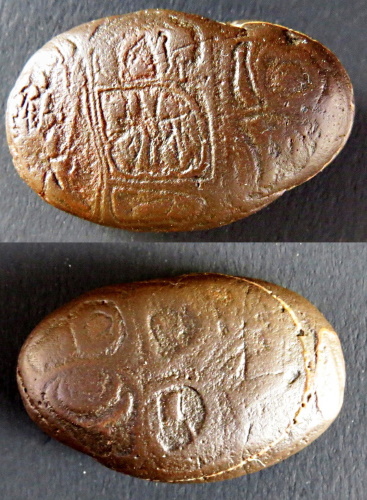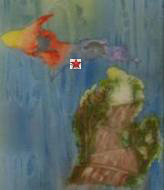MacIntosh Stone
There are mysteries in the past history of Michigan, people who
disappeared, unexplained artifacts, even missing ore. One of the
better known mysteries has to do with the millions of tons of copper
that were extracted from mines on Isle Royale and the Keweenaw
Peninsula. There are thousands of prehistoric copper pit mines in
the western upper peninsula. There are thousands of ancient pit
mines on Isle Royale alone. Tons of copper were removed from these
mines, some say as many as 500,000 tons were removed before the
1800s when modern mining began. The problem is, much of that copper
is missing from North America. No one knows where that copper went.
The questions and speculations, about the missing Great Lakes
copper, have been covered in books and articles. The subject was
even an episode or two, of the television program, America
Unearthed. The speculation is, that mariners made their way to North
America thousands of years ago, to mine that copper for the ancient
world. It supposed that these seafarers were Egyptian, Phoenician,
Chinese, or even Vikings.
 Some
enigmatic objects have been found in the region. One is the
MacIntosh Stone. In the mid 1980s, Charley Macintosh was out picking
agates on the tip of the Keweenaw peninsula. Charley was working an
excellent field of stones about 50 feet above the shoreline. As
usual, he picked up likely looking specimens, and put them in a bag.
Back home, he went about cleaning debris from the stones in
preparation for polishing. One stone, when washed, proved to be
covered with odd engravings. The stone is small, about the size of
two dimes laid side by side. It is amazing that it was ever found at
all, amid a million stones of the same size. The stone has a dark
coloration, is almond shaped, and has a whitish vein running through
it. The stone is completely covered with engravings. There are
images set in frames similar to cartouches. The cartouche style
would date these carvings in the first to third millennium BC. High
resolution photos where taken in July 2018. Those photos have
revealed never before seen details.
Some
enigmatic objects have been found in the region. One is the
MacIntosh Stone. In the mid 1980s, Charley Macintosh was out picking
agates on the tip of the Keweenaw peninsula. Charley was working an
excellent field of stones about 50 feet above the shoreline. As
usual, he picked up likely looking specimens, and put them in a bag.
Back home, he went about cleaning debris from the stones in
preparation for polishing. One stone, when washed, proved to be
covered with odd engravings. The stone is small, about the size of
two dimes laid side by side. It is amazing that it was ever found at
all, amid a million stones of the same size. The stone has a dark
coloration, is almond shaped, and has a whitish vein running through
it. The stone is completely covered with engravings. There are
images set in frames similar to cartouches. The cartouche style
would date these carvings in the first to third millennium BC. High
resolution photos where taken in July 2018. Those photos have
revealed never before seen details.
Knight Side – shows a man kneeling in front of another man.
Receiving a blessing? Ship Side – shows a ship in the lower left.
Above the ship is a symbol that has been interpreted as a buckler or
bukla meaning, "thrust out [to sea] at launching.” This stone is a
subject of an article in Ancient American Magazine.
There are a range of opinions on the origin of this object and the correct interpretation of the carvings. Everyone I have consulted agrees that it is authentic and that it is very old. One authority believes this is of Mediterranean origin. Another believes this is Native American.
MEDITERRANEAN “The style of carving, subject matter, and material of the stone clearly indicate an Eastern Mediterranean origin. The images, and cameo or cartouche style, indicate a date around the first to third millennium.” “It seems obviously a human fashioned amulet, with deliberate zoning, to create separation of content loaded images. The white banding is typical of treasured stones from the lithic period of say, 1,000 AD -10,000 BC. The white banding or veining is an important element in determining authenticity. There are two obvious bird heads and possibly a face. Erosion has muddied the other images. It would require extreme relief differentiation to determine what those images depict. This is an enigmatic stone from the distant past, but obviously a former human treasure.” The above led to one interpretation of the carvings as a Phoenician prayer stone. The Phoenicians were a seafaring race, accomplished traders across the known world. More than one of their ships has been found, wrecked, with a cargo of copper. The interpretation states that, the working sailors were illiterate, and many carried a prayer stone, to help him remember the time and order of his daily prayers. Spider images have been around for a long time. They have been connected to powerful myths around the world for thousands of years. The earliest spiders, along with their webs, are painted on the walls of open rock shelters in Spain that date to the Paleolithic Period, at least 10,000 years ago; another obvious Mediterranean connection.
NATIVE AMERICAN Another authority sees clear evidence of Native American symbols and speculates that this stone was probably a fetish. He bases his opinion on the presence of the crescent moon, spider, and phallus, as well as, the possible bird images. He dates this object at around the 1st millennium AD. Objects with similar engravings have been recovered at Cahokia. The spider in particular is a link those mounds. This stone was found just steps from Lake Superior near Copper Harbor, another link to the Cahokia copper trade. “The spider was an important symbol to the people of the Mississippian culture. The body of the spider also forms a cross, with four groups of two legs each coming out of the body.” Various interpretation are that the cross is a symbol of fire, the sun, the center of the earth, or the four cardinal directions. Other opinions state that the spider symbol was especially associated with women. It is also thought that the spider symbolizes weaving, fertility, the center of the earth, balance, and harmony.” “Then there is the the interpretation that the spider symbolizes creativity and is the weaver of the fabric of life. Just as the eagle symbolizes the divine spirit, creation and freedom.” Again, the patina is very rich - that takes time to develop, and the engravings are obviously worn.

